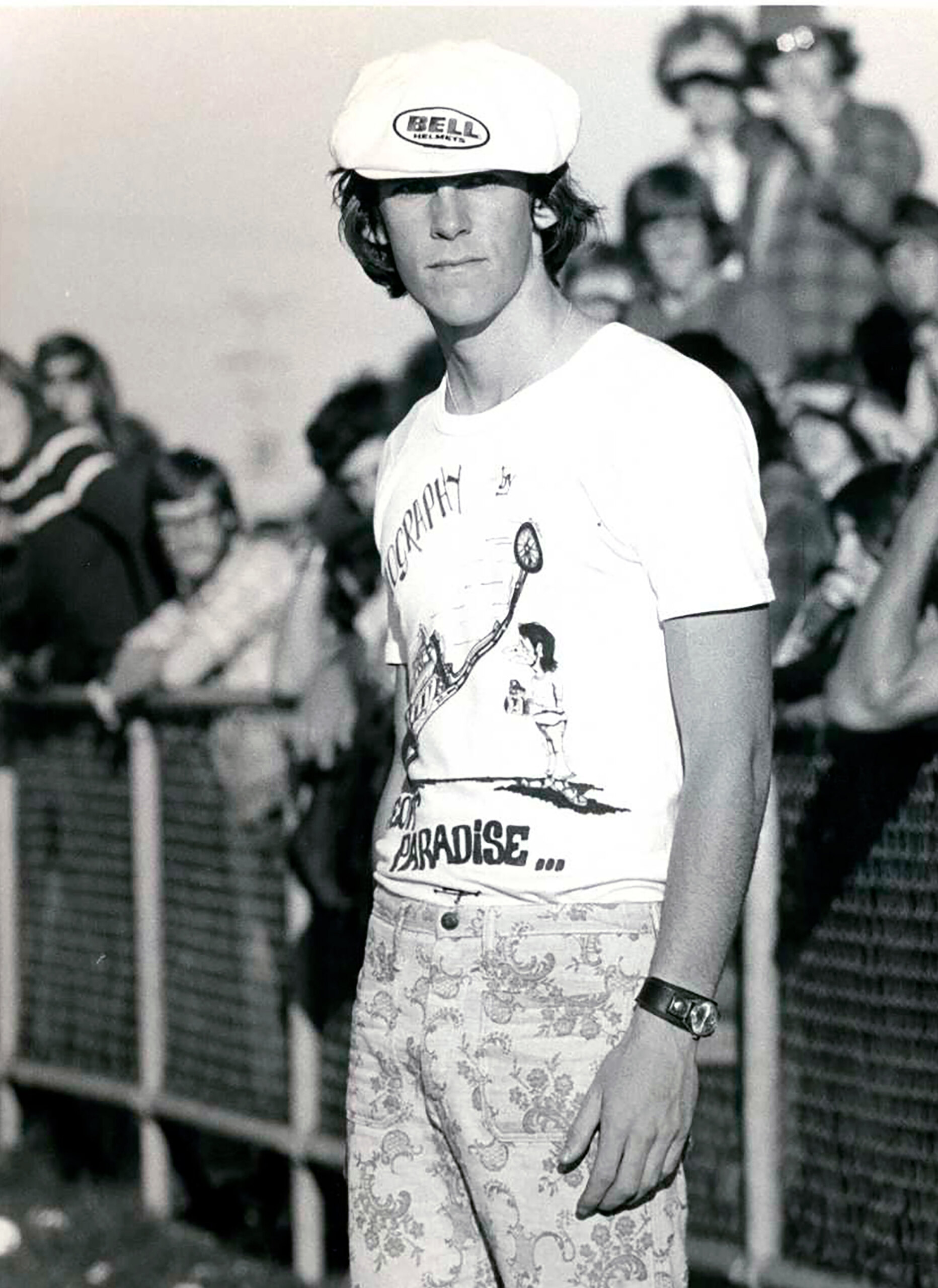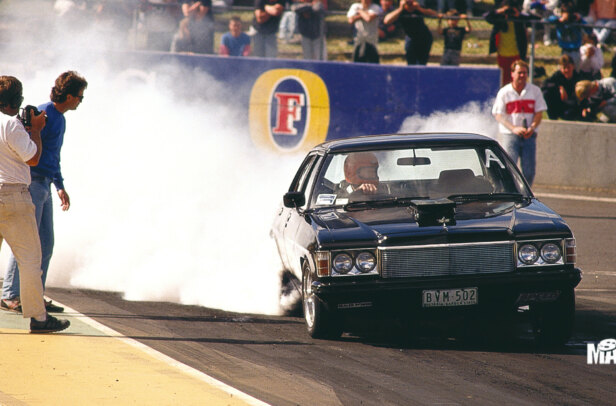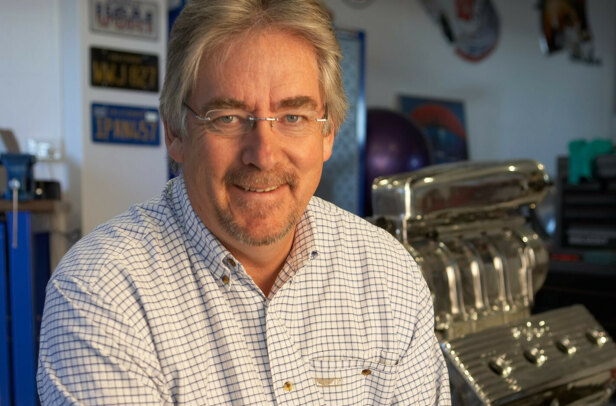Street Machine was born in 1981 from an idea by Geoff Paradise to start a local Aussie magazine in the style of US giants Hot Rod and Car Craft. Rather than start with a fresh title, the suits at Murray Publishers gave Geoff the carcass of Australian Van Wheels, a quirky, irreverent, infrequently published tome that had fallen on hard times.
First published in the August 2006 issue of Street Machine



The Australian Hot Rodding Review (above) was one of many modified car mags that struck up in the 60s. Features were varied, covering pre-’48 rods, street machines, motorcycles, drag racers and even new V8 Fairlanes! Its successor, Van Wheels was more ‘lifestyle’
Van Wheels had itself previously succeeded The Australian Hot Rodding Review which, despite its title, had covered a broad range of modified and performance cars and even motorcycles since the mid 1960s, and so was probably a lot closer to what Paro had in mind than titillating Van Wheels.
This was hardly surprising in the circumstances. Geoff Paradise got his first taste of journalism when in 1970, as a 16-year-old apprentice, he wrote to then AHRR editor Kevin Wolfe to tell him his photos were crap. Wolfe replied: “If you think you can do better, do it yourself.” Geoff submitted his first feature to AHRR soon after, on a local dune buggy. He soon gave spray painting the flick, took up journalism and within three years he was AHRR’s editor, proving just how much he took Wolfe’s words to heart.

Paro then shot through to the United States, where he picked up a gig as features editor on Hot Rod, then the biggest selling car magazine in the world and a stablemate of Geoff’s favourite, Car Craft. Like AHRR, Hot Rod didn’t restrict itself to pre-1948 cars, instead including lots of muscle cars and drag racing in its mix.
While Geoff was immersing himself in US car and magazine culture, AHRR also fell on hard times and, by the time he returned to Australia in 1976, it was dead and buried. And from its ashes had risen the problem child Van Wheels.

VW wasn’t such a bad idea – panos were as popular as Led Zeppelin in the 70s, with well deserved reputations as mobile bedrooms which boosted their cool factor even more – but the magazine was not well supported by its management. It never had a regular publishing frequency and few who worked on it had much genuine empathy for vans or even V8s. By 1980, it too was lined up for the knackery, saved at the 11th hour by the man from Hot Rod.
Paro was a passionate modified car tragic. His first issue, headed Van Wheels & Street Machine, was published in August 1981, but only after much discussion on the name. AHRR and VW had both been published by the same house that published Wheels and its motorcycling offshoot, Two Wheels. Obviously on a roll, management’s ideas for the revamped mag included Hot Wheels, Chrome Wheels and Hot Wheels & Chrome Pipes.

“I said, hang on guys, let’s call the magazine what it is, Street Machine,” Geoff recalls. Luckily for us, the suits bought it.
That first issue featured John Strachan’s wild ‘Alley Cat’ pano and Dave Ryan’s 400-cube Pontiac GTO on the cover. It sold a heady 24,500 copies at $2 a pop, at a time when sister mags Wheels and Motor were selling around 60,000 and 45,000 respectively. But Paro and his small team knew they were on a good thing.


The mastheads were swapped for the second issue: Street Machine was prominent and Van Wheels relegated to a minor strap line. Just so that there was no confusion, the cover cars were Norm Longfield’s big-block Corvette and Brian Horsman’s blown small-block Monaro (shown above). The dual masthead continued until the sixth issue, published in June 1982, by which time sales had pushed through 30,000 copies.
Paro left Street Machine after a well-documented dust-up with his new bosses at Australian Consolidated Press in early 1985, but not before his celebrated cover of August/Sept 1984 featuring Chris Christou lighting up the bags of HO 775 pushed sales past the 50,000 mark for the first time (shown above). Geoff went on to establish Performance Street Car and Fast Fours & Rotaries, the latter of which is still around under new owners. He’s still in the business as publisher of a heavy duty truck magazine and still dabbles in cars, putting the finishing touches to his infamous ’57 Chev while he constructs his latest project, a trad-style blown Hemi-powered Ford roadster.

His replacement was a savvy young journo from The Sydney Morning Herald, Phil Scott. Phil wasn’t the hands-on greaser that Paro was but he sure knew a thing or two about editing car magazines and milking marketing budgets. At the end of 1985, he increased publishing frequency from six issues to eight per year and, aided by an uncanny ability to draw blood from stones, introduced regular car giveaways to boost circulation and readership. These gems included an original A9X with 13km on the clock and an unmolested Phase III GTHO! Sales peaked at 120,000 copies in September 1987, the cover featuring the aforesaid Torana.
Scotty’s other great legacies were his unflinching support for fledging show promoter Chic Henry and his all-new Summernats Car Festival (we paid for the burnout pad, underwrote the event and signed on as naming rights sponsor) and launching Street Machine of the Year in 1988 with a $10,000 cash prize.



Writing in the 10th anniversary issue in 1991, Phil summed up his approach and the magazine’s philosophy: “We’ve always endeavoured to give you the best cars, stories and photos (because) we genuinely have a real interest in street machining. Everything we do is aimed at expanding our sport. That’s why we make the effort to cover Summernats with so much gusto and give away $10,000 to the Street Machine of the Year. Street Machine has done more for this sport than all the other magazines put together.”
Phil went on to edit Wheels, then took on management roles at ACP and later The Sydney Morning Herald, as well as getting his mug on TV. He later returned to ACP Magazines as Group Publisher.


Not surprisingly, Phil was a hard act to follow and Street Machine entered a decade of slow decline, relinquishing the number one spot to Wheels in June 1994, by which time our circulation had fallen to 55,000 copies. For a period there, Street Machine was edited by mainstream car journos whose eyes were firmly focused on the Wheels gig, although Todd Hallenbeck gave it a good ol’ go during 1995 and 1996. Nor could anyone deny his successor Mark Oastler’s knowledge of and genuine affection for 60s and 70s muscle cars, Mopars in particular.
Even so, by the time we started assembling my dream editorial team in 2000, sales had dipped below 50,000 copies, advertising revenue was falling and we’d been shunted out to the north western suburbs of Sydney, well away from the ACP hub. Worst of all, management was seriously suggesting we dump the ‘dinosaur’ V8s for late-model, high-tech stuff. Their days were over, they were saying, just like Van Wheels.



That that didn’t happen is obvious to all, but it was touch and go there for a while. Instead, we recommitted ourselves to covering traditional V8 street machines and hot rods and the cycle slowly turned back our way. We revamped the magazine’s presentation, even picking up some industry awards along the way. Old cars became cool again, Sydney got a flash new dragstrip, V8 Supercars boomed and our fortunes turned. We’ve been publishing monthly since November 2000, circulation is back to around 70,000 per issue, and readership up to over half a million. We’re back in the ACP fold, enjoying our new digs in the city and it’s all good.
But wait, there’s more
Since the above article by Geoff Seddon was published in 2006, Street Machine has been on a wild ride! James Packer sold ACP to private equity groups CVC Asia Pacific, CVC Europe and CVC Tandem in 2008, just before the financial crisis hit.
CVC then sold ACP Magazines to German publishers Bauer Media in 2012.
A year later, Street Machine and the other motoring magazines in the stable moved south to Bauer’s Melbourne outpost. Of the Seddo-era team, only Simon Telford was able to make the move to Melbourne. He was appointed editor and brought contributor Scott Taylor and work experience wunderkind Povi Pullinen with him as the foundation of a new team.
The scope of Street Machine expanded rapidly from there, as we diversified into the events with Drag Challenge, YouTube with Carnage, books and a much-expanded merch offering.
Bauer sold its magazine business to private equity firm Mercury Capital in 2020 and the automotive mags were reorganised under the Wheels Media banner.
And now, we have joined the Out There Group, home of the Street Machine Summernats, Meguiar’s MotorEx and the new National Drag Racing Championship, amongst many other events. After years of being the black sheep in a very corporate media company, it feels like we are finally arriving at our true home. Big things await!
Sexual Vantasy

Goeff Paradise once described Van Wheels as “sometimes clever, always bizarre”. It was certainly a memorable magazine and one that has aged well: more than a quarter of century later, its unique mix of vans, performance engines, technical stuff, humour and half-naked sheilas still makes for an entertaining read.
Launched by Bruce Flynn but edited for most of its life by Brian Woodward, it was published at infrequent intervals by a shifting editorial team recruited from other Murray Publishing titles like Wheels, Two Wheels and Modern Motor. Few had any real interest in panel vans or even V8s, but Woodward in particular had a wicked sense of humour and a good grasp of magazine craft.
Many of the foundations of Street Machine can be traced back to Van Wheels, such as the introduction of Your Stuff in issue #3. In other respects it continued much of the style of its predecessor, The Australian Hot Rodding Review: lots of ‘how to’ technical features; show and event coverage; illustrators hired to dream up new styles and ideas; engines almost always V8 or Holden straight six. Sound familiar?





What is less familiar about Van Wheels these days are the saturation tobacco ads (the ringtone ads of their day) and the bosoms, generally three of four pairs an issue, plus the occasional naked buttock. This fitted in with the adolescent sexual fantasies that surrounded panel van ownership, and even the realities, just quietly, for many of us who were there.
Alas, Woodward moved on to Modern Motor during issue #7 and Van Wheels lost what focus (and circulation) it had. It stumbled on for a few more issues before Paro arrived on the scene with a brief for a radical shake-up. He immediately announced, in issue #10, that things were about to change.
“In future issues of Van Wheels,” he wrote, “you are going to see vans so customised they will resemble sedans, sedans with blowers, sedans with turbochargers, sedans with fat tyres. I fink (sic) they call them ‘street machines’.”
Paro was true to his word, and the first issue of Van Wheels & Street Machine went on sale a few months later.
Wayne & Vicki

The best comic strip in the history of Aussie car mags, Wayne & Vicki, launched in December 1981, and ran for two years in Street Machine before artist Brendan Akhurst took the strip to Street & Custom and later Super Street.
Practise What We Preach

We can’t help ourselves when it comes to building project cars, almost all of which we’ve given away to readers. The exception was the Wild Child WB ute (above), which we drove into the ground instead. Every time we finish one we swear we will never build another, but we always do.
- HQ For You: Small-block powered LS Monaro coupe
- Castrol Coupe: 351ci XC coupe with wild graphics
- One HO To Go: Injected 351ci XE ESP
- Compact Fairlane: Howard Astill masterpiece
- Wild Child: 5.0l WB rust bucket
- Sony Scorcher: Two-door, 240km/h V8 EA Falcon
- VUFORU: The first VU ute to sport 24in rims!
- Comfort Cruiser: 428ci Galaxie convertible
- Dodge Dart Swinger: Our toughest give-away car ever!
V8s ’til ’98
After Holden dropped the 253ci V8 from the VH Commodore, word spread in early 1984 that the 308 was also likely to get the shove. Unleaded petrol was on its way from January 1986, Holden’s future lay with smaller cars, and that was going to be that.

Street Machine editor Geoff Paradise and Wheels editor Peter Robinson teamed up with The Herald’s Phil Scott to launch their ‘V8s ’til ’98’ campaign. Aided and abetted by moles deep inside Holden, the subsequent letter-writing campaign convinced Holden to re-engineer the 308 for unleaded, which returned in the VL.
This engine would form the basis of the Walkinshaws and what would eventually become HSV. Pretty hard to imagine what performance car folk would think of Holden today if Geoff, Phil and Robbo hadn’t taken their stand.



Comments